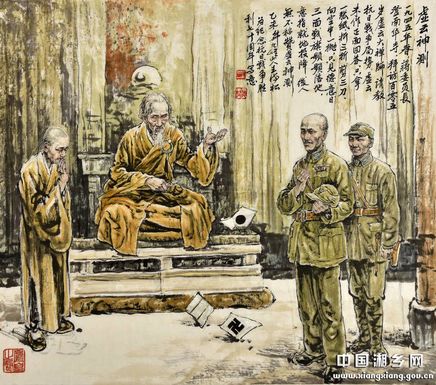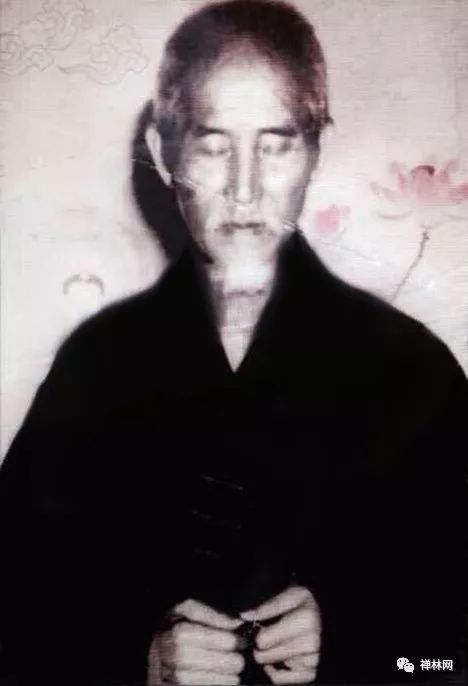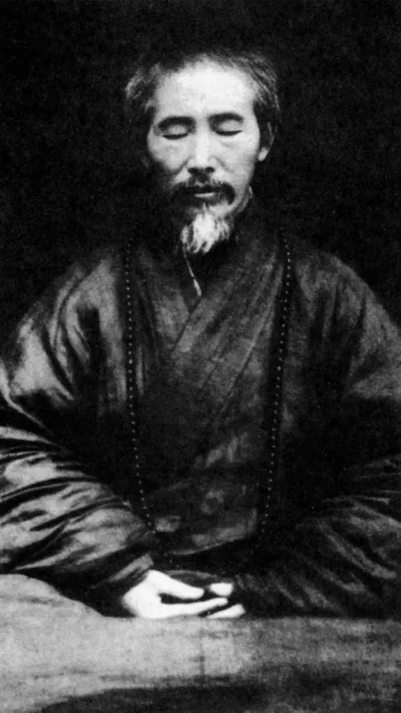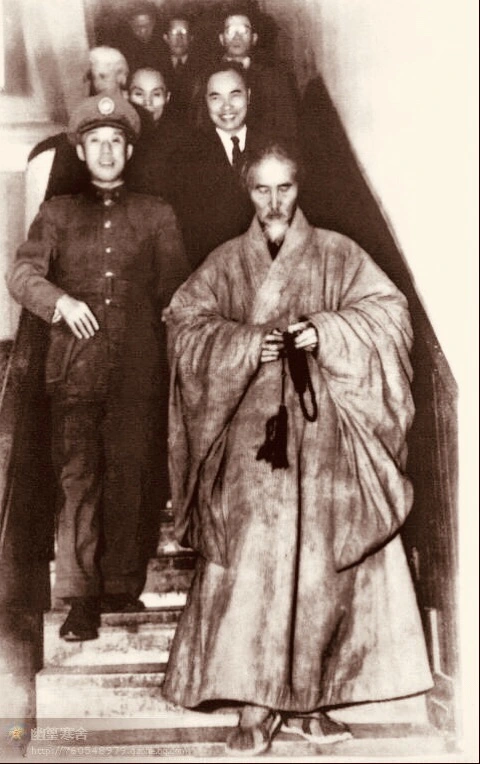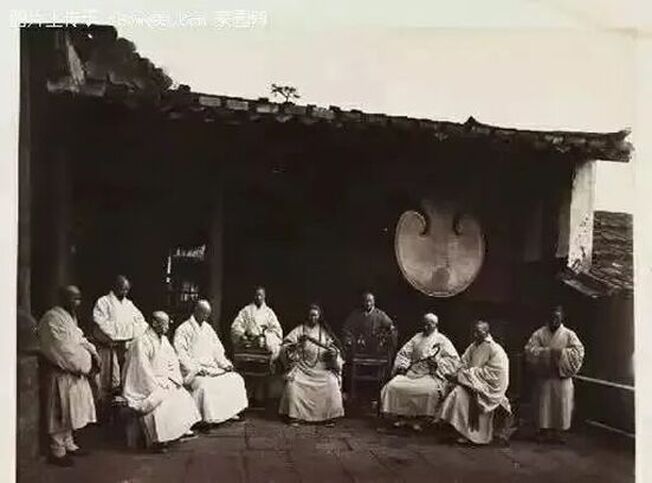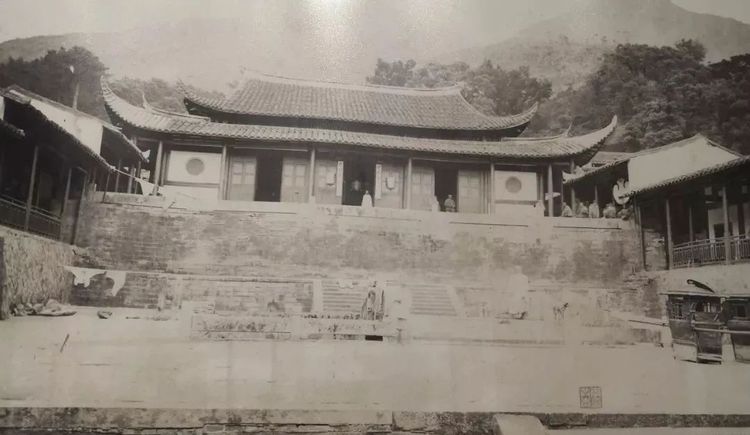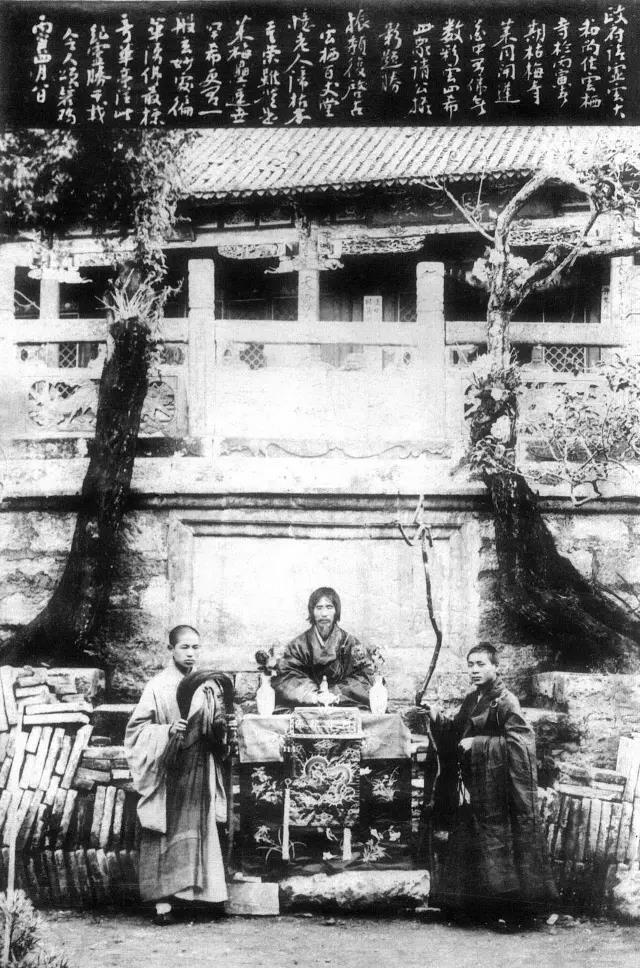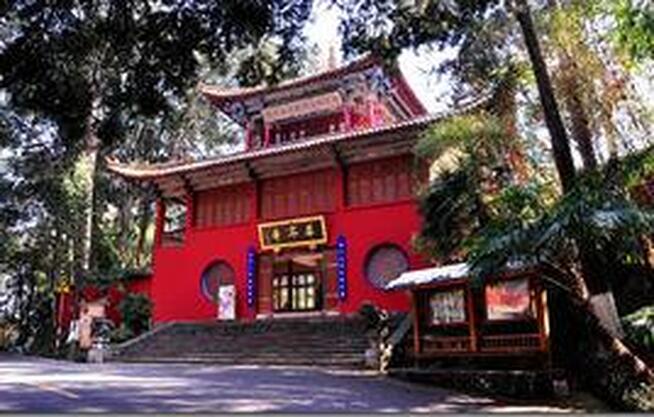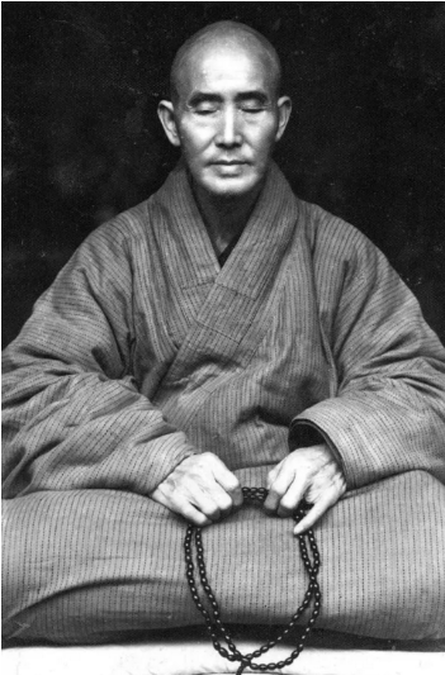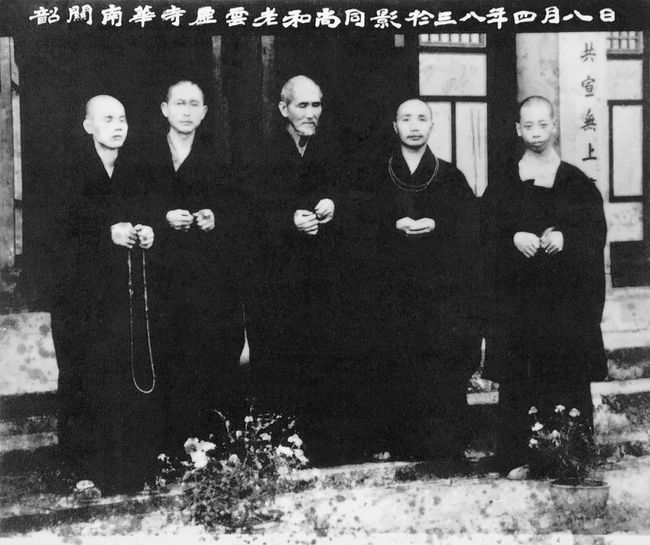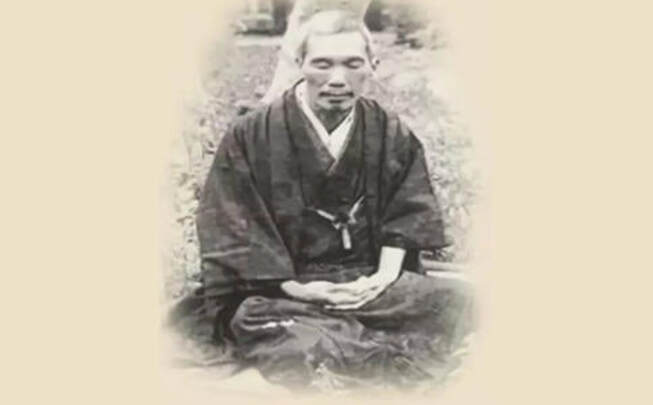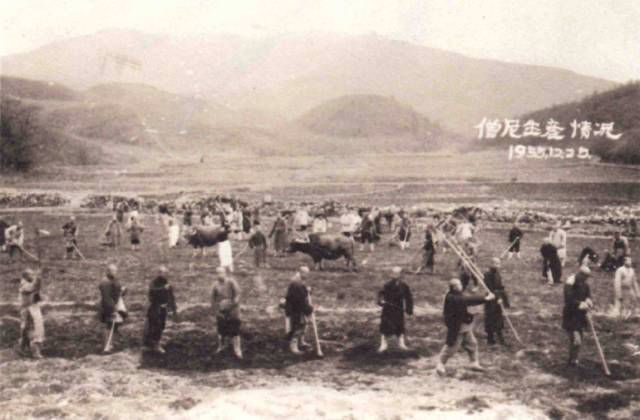Master Xu Yun (1840-1959) Memorial Photographic Library
ICBI LIBRARY NUMBER: 0071
Charles Luk’s English translation of Master Xu Yun’s biography entitled ‘Empty Cloud’ (the 1988 Element Books edition revised by Richard Hunn) states for 1943/44 (when Master Xu Yun was in his 104th year of age) the following information (Page 129):
‘In the first month, I performed rituals for the welfare of the country which ended on the twenty-sixth day. President Lin-shen, General Jiang Gai-shek, Minister Dai, General Ho and other high officials invited me, one after the other, to vegetarian meals. General Gai-shek enquired about the Dharma in detail, listening (to) the various points on materialism and idealism, as well as the doctrine of Christianity. I replied to his inquiry in a letter.’
Although this letter from Xu Yun to General Jiang Gai-shek (refuting the relevancy of Christianity for China), appears in the original Chinese language text of his biography – Charles Luk did not include it in his ‘Empty Cloud’ English translation, but it can be read here (in a ‘new’ translation):
Xu Yun’s Letter to Chiang Kai-Shek
Furthermore, the Chinese text accompanying this photograph tells a more complete story, which does not appear in Empty Cloud. This is not unusual, as Empty Cloud is based on the earliest (and often incomplete) drafts of Xu Yun’s biography. As time progressed, more and more stories and evidence came to light, and this information was integrated into later editions of Xu Yun’s biography. Although the above is an artist’s impression of the meeting, and not a photograph, it is included in this photographic library due to the extraordinary story it conveys. The dates slightly vary, but again this is not unusual when translating traditional Chinese years into Western years, as there is not an exact correlation. In the spring of 1945, when Xu Yun was 105 years old, General Jiang Gai-shek visited the Nan Hua Temple to consult with the Venerable Ch’an Master Xu Yun. Whilst standing respectfully in front of the seated Xu Yun, General Jiang Gai-shek enquired about how the War of Resistance against the Japanese invaders was going in the area? Master Xu Yun did not acknowledge the question, but remained silent. Instead, Xu Yun took a single sheet of paper and cut it with a knife into three equal parts, and threw the pieces up into the air. As the three pieces of paper fell to the ground, each piece manifested a flag of the enemy Axis Countries – namely Nazi Germany, Fascist Italy and Imperial Japan – indicating that all three were either defeated or very close to defeat. All those present praised the sage-like qualities of Master Xu Yun!
一九四五年春,蒋委员长登南华寺,拜访百零五岁虚云大禅师,请教抗日战争局势,虚云未作正面回答,只拿一张纸,折三折,剪三刀,向空中一抛,只见德、意、日三面战旗频频落地,意指就地投降,后人无不称赞虚云神测。
A special note from Mr Wang Ping:
An interesting 'sketch' of Master Xu Yun (1840-1959) has been added to the main ICBI site. The accompanying (translated) story does not appear in Xu Yun's biography - but is indicative of the many unusual happenings that Xu Yun experienced, or others experienced when in his company. The late Ch'an Master Jing Hui spent much of his lifetime gathering as many extra stories as he could find about Xu Yun - eventually creating a much expanded version of his biography in China (not yet available in English translation). Just what this story means is unclear, as the Chinese text gives the impression that three flags 'spontaneously' appeared on three pieces of paper - and that these manifestations were 'willed' by Xu Yun himself. As all genuine Ch'an practitioners do not fall into the trap of irrationality or illogicality, I doubt this 'literal' interpretation. I would suggest that this scenario is the 'impression' that a by-stander or a witness think they saw. Nevertheless, the symbolism this event holds is very important. Xu Yun kept aloof from the trivialities and delusions of the common world (and certainly had his differences with Chiang Kai-Shek), this is why he refused to 'acknowledge' the legitimacy of Chiang Kai-Shek's question regarding the extent of the local Chinese resistance to the Japanese invasion of China. It seems that Xu Yun threw the flags of the fascist countries to ground mimicking the act of throwing the legal documents of those sentenced to execution in ancient China (which were thrown to the ground in-front of the condemned - usually with their names 'crossed-out').
Many Blessings
Gratitude in the Dharma!
Mr Wang Ping (王平)
Secretary - ICBI (Beijing Office)
‘In the first month, I performed rituals for the welfare of the country which ended on the twenty-sixth day. President Lin-shen, General Jiang Gai-shek, Minister Dai, General Ho and other high officials invited me, one after the other, to vegetarian meals. General Gai-shek enquired about the Dharma in detail, listening (to) the various points on materialism and idealism, as well as the doctrine of Christianity. I replied to his inquiry in a letter.’
Although this letter from Xu Yun to General Jiang Gai-shek (refuting the relevancy of Christianity for China), appears in the original Chinese language text of his biography – Charles Luk did not include it in his ‘Empty Cloud’ English translation, but it can be read here (in a ‘new’ translation):
Xu Yun’s Letter to Chiang Kai-Shek
Furthermore, the Chinese text accompanying this photograph tells a more complete story, which does not appear in Empty Cloud. This is not unusual, as Empty Cloud is based on the earliest (and often incomplete) drafts of Xu Yun’s biography. As time progressed, more and more stories and evidence came to light, and this information was integrated into later editions of Xu Yun’s biography. Although the above is an artist’s impression of the meeting, and not a photograph, it is included in this photographic library due to the extraordinary story it conveys. The dates slightly vary, but again this is not unusual when translating traditional Chinese years into Western years, as there is not an exact correlation. In the spring of 1945, when Xu Yun was 105 years old, General Jiang Gai-shek visited the Nan Hua Temple to consult with the Venerable Ch’an Master Xu Yun. Whilst standing respectfully in front of the seated Xu Yun, General Jiang Gai-shek enquired about how the War of Resistance against the Japanese invaders was going in the area? Master Xu Yun did not acknowledge the question, but remained silent. Instead, Xu Yun took a single sheet of paper and cut it with a knife into three equal parts, and threw the pieces up into the air. As the three pieces of paper fell to the ground, each piece manifested a flag of the enemy Axis Countries – namely Nazi Germany, Fascist Italy and Imperial Japan – indicating that all three were either defeated or very close to defeat. All those present praised the sage-like qualities of Master Xu Yun!
一九四五年春,蒋委员长登南华寺,拜访百零五岁虚云大禅师,请教抗日战争局势,虚云未作正面回答,只拿一张纸,折三折,剪三刀,向空中一抛,只见德、意、日三面战旗频频落地,意指就地投降,后人无不称赞虚云神测。
A special note from Mr Wang Ping:
An interesting 'sketch' of Master Xu Yun (1840-1959) has been added to the main ICBI site. The accompanying (translated) story does not appear in Xu Yun's biography - but is indicative of the many unusual happenings that Xu Yun experienced, or others experienced when in his company. The late Ch'an Master Jing Hui spent much of his lifetime gathering as many extra stories as he could find about Xu Yun - eventually creating a much expanded version of his biography in China (not yet available in English translation). Just what this story means is unclear, as the Chinese text gives the impression that three flags 'spontaneously' appeared on three pieces of paper - and that these manifestations were 'willed' by Xu Yun himself. As all genuine Ch'an practitioners do not fall into the trap of irrationality or illogicality, I doubt this 'literal' interpretation. I would suggest that this scenario is the 'impression' that a by-stander or a witness think they saw. Nevertheless, the symbolism this event holds is very important. Xu Yun kept aloof from the trivialities and delusions of the common world (and certainly had his differences with Chiang Kai-Shek), this is why he refused to 'acknowledge' the legitimacy of Chiang Kai-Shek's question regarding the extent of the local Chinese resistance to the Japanese invasion of China. It seems that Xu Yun threw the flags of the fascist countries to ground mimicking the act of throwing the legal documents of those sentenced to execution in ancient China (which were thrown to the ground in-front of the condemned - usually with their names 'crossed-out').
Many Blessings
Gratitude in the Dharma!
Mr Wang Ping (王平)
Secretary - ICBI (Beijing Office)
ICBI LIBRARY NUMBER: 0072
According to a 2021 Chinese-language article published in the Mainland (referenced below), this picture is considered the only 'colour' photograph ever taken of Master Xu Yun. The background wall is 'off-white' or perhaps 'beige' (light-brown), whilst the flower-pattern visible to the right of Master Xu Yun's shoulder is light-pink. His robe is black and his skin appears to 'shine'. There are a number of photographs from 1947 where Master Xu Yun is dressed identically and adopts a similar physical position and attitude of mind. The Soviet Red Army - at the behest of their allies the UK and US - entered Northeast China and destroyed the Japanese Imperial 'Kwantung' Army during late 1945 and organised the Japanese surrender into 1946. Master Xu Yun's autobiography states that during 1946-1947 WWII came to an end in China and all Chinese governmental departments returned to their original locations. A number of officials and notables invited Master Xu Yun to visit Guangzhou in November in order to visit various temples and hold ceremonies for the welfare of the dead. At one-point, over 100,000 people attended the 'Six Banyans' Temple! Photographs from this time record Master Xu Yun also visiting the 'mansion' of a the Nationalist Official known as ' Zou Lu' (邹鲁) situated in Dapu County, Guangdong province. Did 'Zou Lu' have access to colour photography? A few months later - during Spring 1947-1948 - Master Xu Yun was back in Nanhua temple transmitting the Vinaya Discipline Precepts before leaving to visit Hong Kong and then Macao. After this, he returned to Yunmen Temple (also in Guangdong) to hurry along the repairs.
虚云老和尚唯一彩色照片
虚云老和尚唯一彩色照片
ICBI LIBRARY NUMBER: 0073
It is said in China 'Venerable Old Master Xu Yun: The wind cannot move him, the rain cannot get him wet.' (虚云老和尚:风吹不入,雨打不湿). During the Spring of the 22nd year of the Republic of China (1933), a laymen called 'Gong Delin' (功德林) arranged a Seven Day Ch'an Week Retreat in another area of Fujian province - but Master Xu Yun got to hear of it and decided to quietly go and sit at the back of the crowded room. Although he was the 'Head Monk' of Yongquan Temple - he travelled and dressed like a pauper and a beggar. Although his head was covered - news spread that Master Xu Yun was in attendance! Hundreds queued to bow their fore-heads to the floor and pay Master Xu Yun respect! For quite sometime, Master Xu Yun did not move or acknowledge their presence. He simply kept meditating. Eventually he exclaimed' What are doing? Don't you understand that time is short and that you must use it wisely to realise your own minds? I am nothing - just like dust! Why are you worshipping dust rather than discovering your own empty-mind ground? I will eventually disappear but the empty mind ground - like Amitabha Buddha - will shine on forever! Pursue your method with vigour and do not be distracted by worthless old men who wander around aimlessly!'
ICBI LIBRARY NUMBER: 0074
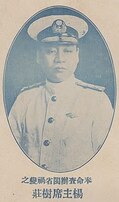 Admiral Yang Shuzhuang
Admiral Yang Shuzhuang
When the Christian Chiang Kai-Shek ordered destruction of the famous Shaolin Temple of Henan during 1928 - Master Xu Yun remained 'silent' with his autobiography omitting this awful event. Why would the acknowledged head of the Chinese Ch'an tradition not criticise this terrible atrocity? After-all, the physical and spiritual centre of Chinese Ch'an Buddhism had been destroyed and the monks murdered and the survivors scattered. The Western world remained equally 'silent'. The Shaolin Temple was the place where numerous Indian monks had visited whilst transmitting Indian 'Dhyana' (Jhana) Buddhism to China. Master Xu Yun was keeping his spiritual powder 'dry' whilst working behind scenes to undermine the right-wing dictatorship! In this photograph, Master Xu Yun is recorded as being with 'Yang Shuzhuang' (杨树庄) [1882-1943] (LEFT) and 'Fang Shengtao' (方声涛) [1885-1934] (BEHIND RIGHT). Yang Shushuang was a prominent (and high-ranking) member of the Nationalist Navy and as a supporter of Sun Yatsen managed to avoid any direct association with Chiang Kai-Shek. He was a devout Buddhist and was closely associated with the 'Yogquan' Temple, (Gu-Shan) in Fujian province. He died of illness in 1934 whilst visiting Shanghai (with his body being returned to the 'Yongquan' Temple for cremation). Fang Shengtao, on the other hand, was a progressive Nationalist politician who became a Commander in the Second Tier of the 'National Protection Army' (stationed in Yunnan) during 1915 under Commander Li Liejun (李烈钧). Three years earlier, Master Xu Yun had personally intervened in this region - preventing the Nationalist Army from carrying-out punitive action against the ethnic Tibetan population. As both men died relatively young and in Shanghai (during 1934), and given that Feng Shengtao became a Ch'an Buddhist monk in 1932 - this picture appears to have been taken at some point between 1929-1932 - during the era that Master Xu Yun was the 'Head Monk' of the Yongquan Temple - a place both men were closely associated with. An accompanying note, however, suggests that this might be the 'Ciyum' (慈云) Temple situated in the Nan'an District of Chongqing City (formerly of Sichuan province but now independent). According to Chinese-language records, Master Xu Yun was active in this region during 1927 raising funds for temple repair and monastic renovation, etc. During this time, Master Xu Yun also delivered important Dharma-lectures. This picture suggests such a lecture has just ended. The temple changed its name to 'Ciyun' '('Loving-Kindness Cloud') at this time with the refurbishing occurring in 1936. This is the only Ch'an temple in China where Ch'an monks and nuns live together in the same complex of buildings.
虚云老和尚于重庆慈云寺重要开示
虚云老和尚于重庆慈云寺重要开示
ICBI LIBRARY NUMBER: 0075
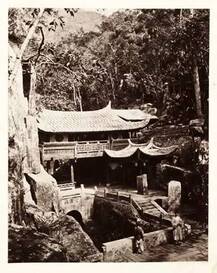 1860: 'Yongquan' Temple with Monks Featured!
1860: 'Yongquan' Temple with Monks Featured!
According to Chinese language sources, the above picture (and the others featured in this entry) were taken by the young American citizen named 'Edward Francis Jones' often shortened to 'Ted Francis Jones' and expressed in the written Chinese language as '特德法朗西斯琼斯'. He is usually described as being 'young' or 'youthful', etc. He is responsible for a number of early photographs record the 'Yongquan' (涌泉) Temple in Fujian province. Although there are extensive lists of Christian missionaries available on the internet, and despite there being a number of Westerners living in China around this time, I cannot quite match the name properly as of yet, although this may be an ongoing work in progress. What is important is that a number of people in China believe that Master Xu Yun is depicted in this photograph as a young Ch'an monk, as he left home and entered 'Yongquan' Temple and has his 'head shaved' in 1859 when he was around 18-years-old. I suspect an old box-camera obscura was used whereby the participant had to remains perfectly 'still' for a number of minutes if the black and white image was to be 'taken' in a clear fashion without any 'blurredness' interfering with recording the intended image. Obviously, in the case of isolated or remote buildings the chances of capturing a 'clear' image is enhanced by circumstance. It has been suggested that the monks sitting and standing to the left of this photograph are 'Novice' monks, with the 'Master' and Senior Monks sitting in the middle and the fully ordained monks sitting and standing to the right. If Mater Xu Yun is in this picture there is a good chance he is sitting or standing on the left-hand side. Of course, as no one knew him then, and given that a new monk was tasked with giving-up his old life and personal identity, there is no reason for his presence to be recorded or for him to be marked-out in anyway. If Master Xu Yun is in this picture, then the dispute over whether he was born (or not born) in 1840 would be permanently settled!
千年古刹涌泉寺,百年前老照片
千年古刹涌泉寺,百年前老照片
ICBI LIBRARY NUMBER: 0076
The life of Master Xu Yun was often unpredictable, full of legends and interspersed with bizarre happenings. The picture above depicts the 'Head Monk' Master Xu Yun during the Spring (1926) transmission of the Vinaya Discipline Precepts held at the 'Yunqi' (云栖) or 'Cloud Abode' Temple in Kunming (Yunnan province) - better known by its older name of 'Huating' (華亭), or 'Magnificent Pavilion' Temple. Master Xu Yun stayed and rebuilt this temple between 1920-1929. The withered trees (pictured here) situated in-front of the temple suddenly burst into flowers- whilst the green vegetables in the garden were suddenly full of lotus flowers! This all happened after a number of Ch'an Week Retreats involving lay and monastic practitioners training together with Master Xu Yun to realise the empty mind ground. From the pure spiritual soil of the empty mind ground - the withered trees gave birth as if from nowhere - and vegetables developed the off-spring of lotus flowers! All this symbolism occurs dotted throughout the Ch'an literature compiled over centuries. Master Xu Yun tasked Upasaka Zhang Juexian with recording all these extraordinary events and to arrange a stone stele to made with a suitable inscription. Within Charles Luk's English-language translation of Master Xu Yun's Autobiography entitled 'Empty Cloud' (1988 Edition with Richard Hunn), the above temple's name is written as 'Yun-xi'. This takes the second etymology for the Chinese ideogram'栖' (xi1) instead of the more generally accepted first etymology of '栖' (qi1). The ideogram '栖' (qi1) appears to be a simplified version of '棲' (qi1) which carries the identical meanings of 'perch', 'stay' and 'roost', etc. However, having checked and re-checked current and extant Chinese-language dictionary sources, the use of '栖' (xi1) would appear to be incredibly rare. Charles Luk was translating before the internet allowed multiple sources to be accessed and used. Nevertheless, as he lived within the Chinese--language milieu of Hong Kong and had access to individuals who were familiar with Mainland Chinese affairs, it is as if he was 'advised' to use this etymology. It has also been suggested to me that with language standardisation post-1949, 'xi1' could have been replaced with 'qi1' - but I can find no 'historical' evidence for this change. Neither am I aware of any such changes occurring post-1949, other than related simplified ideograms taking the place of their more elaborate counter-parts in schools and literature for the masses.
1926年云栖寺春戒期间虚云老和尚于殿前所摄
1926年云栖寺春戒期间虚云老和尚于殿前所摄
ICBI LIBRARY NUMBER: 0077
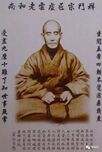 Uphold the Vinaya Discipline!
Uphold the Vinaya Discipline!
Although an extraordinary photograph the events that led up to it only warrant a line or two within Master Xu Yun's autobiography. During Spring 1947, Master Xu Yun carried-out rituals for the well-being of all being (dead or alive) throughout the world in citing the Thousand Buddhas' and the 'Arahants' (Disciples) to protect and guide them! He also taught the Sutras before he transmitted the Great Precepts of the Vinaya Discipline at the 'Nanhua' (南华) Temple situated at Caoxi in Guangdong province. This place is famous for being the temple of the Sixth Patriarch of Ch'an - Huineng - and the place his body has been sat upright within meditating since his passing in 713 CE. Master Xu Yun used to shave his hair and beard just once a year around Spring-Time when he would wash and don a fresh robe. Master Xu Yun was adamant that the foundation of a legitimate Buddhist practice stems from the upholding of the Vinaya Discipline by both monastics and lay-practitioners. It is interesting that Master Xu Yun was never invited to Japan. This is believed to be because he openly criticised the Japanese Zen Schools for not demanding that their practitioners discipline their minds and bodies through the upholding of the Vinaya Discipline! This lack of spiritual self-control led to the Japanese Imperial Army committing terrible atrocities against the peoples of Asia before and during WWII!
虚云老和尚坐禅法像。
虚云老和尚坐禅法像。
ICBI LIBRARY NUMBER: 0078
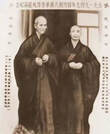 A Typical Lineage Picture.
A Typical Lineage Picture.
From around 1934-1950, Master Xu Yun would use the Nanhua (南華) Temple in Guangdong as his central place of residence. Indeed, between 1934-1940 he spent his time repairing and rebuilding the Nanhua Temple (which houses a number of important Ch'an Buddhist relics including the upright sitting [mummified] bodies of Huineng - the Sixth Patriarch [d. 713] - and Master Hanshan [d. 1623]). From 1940-1950, Master Xu Yun would switch between raising funds and personally over-seeing the reconstruction at the Yunmen (雲門) Temple situated 28 miles West of Nanhua. In this photograph taken in the Nanhua Temple during 1949, Master Xu Yun stands with what is assumed to be four Ch'an monk disciples, with the second from right being recorded as the Ch'an monk - or Dharma Master 'Ben Huan' (本焕). On occasion, this picture is often 'edited' so as to only portray Master Xu Yun and Master Ben Huan (1907-2012) presumably for 'lineage' purposes. Master Ben Huan was '104-years-old' when he passed away. As a Dharma-Inheritor of Master Xu Yun - his lectures and Ch'an teaching activities were very popular throughout China - with Master Ben Huan's Dharma-Words starting to become better known in the West!
1949年虚云老和尚在南华寺与众位法师合影,右二为本焕法师
1949年虚云老和尚在南华寺与众位法师合影,右二为本焕法师
ICBI LIBRARY NUMBER: 0079
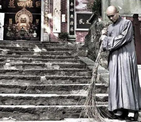 The Ch'an of Hard Labour!
The Ch'an of Hard Labour!
Shi Ju Xing (釋具行) [1876-1924] was a Disciple of Master Xu Yun who was believed to be 'deaf' and was illiterate when he ordained. His common name was '日辯' (Ri Bian) and his family originally came from the Dali area of Yunnan province. When he was young, his parents died and he was adopted by the '氏' (Shi) family - who had two children of their own. During 1896, (that is the 33rd year of the reign of the Emperor Guangxu [光绪]), there was a famine in his local area but a married Ju Xing heard that Master Xu Yun was in the 'Jizu' or 'Rooster's Foot' (鸡足) Mountain area of Yunnan rebuilding Buddhist temples, and decided to visit him and ask if he could help relieve the suffering of his family. Master Xu Yun treated Ju Xing with kindness and consideration despite others calling him 'ugly' due to the fact he was deaf and could not speak properly. Master Xu Yun suggested that he 'volunteer' to work in the monastery without wages and just a single bowl of watery-rice a day to build and generate good karmic energy used to benefit everyone. So grateful was Ju Xing that he bowed his head to the floor at Master Xu Yun's feet two-hundred times, and Master Xu Yun understood that he and this young man shared a deep karmic association! This is how Ju Xing renounced the world and became a Ch'an monk under Master Xu Yun.
Ju Xing took it upon himself to clear a piece of waste-land on the temple grounds and cultivate the land to grow fruit and vegetables which he shared freely with the local community. He worked hard all day and focused his mind fully upon the difficult physical labour. This productive physical labour became his Ch'an practice. When he reached 21-years-old, Master Xu Yun permitted him to fully ordain (in 1897). This is when he was given the Dharma-Name '具行' (Ju Xing), or 'Possess Vinaya Discipline'. During the year 1909, (the 1st year of the reign of the Emperor Xuantong [宣統]), Ju Xing's entire family of eight members - including his wife, sons, nephew, brother, sister-in-law and mother-in-law, etc - were all ordained by Master Xu Yun. Originally, the Yunqi (云栖) Temple was not allowed to take in female monastics, but Master Xu Yun saw that Ju Xing's family was alone and took them - allowing them to build a few thatched huts out of the way on the back mountain. Ju Xing had to work all day without paying any attention to worldly events happening around him (as if 'deaf' to the world), whilst at night he had to study the Sutras and engage in seated meditation. This he did with a great diligence!
To avoid attachment to one place (and one teacher) Master Xu Yun ordered that Ju Xing leave the mountain in 1915, and travel around and deepen his understanding of the Dharma under other teachers. In 1924, a deeply enriched Ju Xing returned to the Yunqi Temple and became an able assistant to Master Xu Yun - who knew that he was an extraordinary being! Indeed, Master Xu Yun is said to have known that Ju Xing's '坐化' (Zuo Hua), or 'Seated Transformation' was near! All day long Ju Xing went about his duties reciting 'Amitabha!' without end! Now fully ordained, Ju Xing requested that Master Xu Yun confirm his spiritual attainments and physical abilities. Ju Xing could now read and recite the Sutras without error or pause, and he gardening skill was declared superb by Master Xu Yun! He would continue to bow at Master Xu Yun's feet and explain that his time was now up in the world and that it was time to leave! Master Xu Yun agreed but kept a close eye upon Ju Xing's practice. Master \Xu Yun recalled:
''While I was at Sheng-yin Temple, I noticed his work in the gardens and inner cultivation which was exemplarory and rarely found. That year, during the transmission of the rules of discipline elsewhere on the mountain, he came and asked me to verify his achievements and after he had been fully ordained, he asked for leave to return to Sheng-yin Temple.
On the 28th of the third-month, after mid-day meditation he went to the courtyard behind the main hall where he put on his robe, heaped-up some bundles of straw and sat upon it cross-legged, his face turned toward the West, reciting the Buddha's name, and then, with one hand ringing the bell and the other beating the wooden fish, he set fire to straw. The numerous people in the temple at first knew nothing about what was happening, but when those outside saw the blaze they entered the temple but could not find the Bhiksu. When they went to the courtyard, they saw him sitting motionless with cross-legs on the ashes. He clothing was intact but the wooden fish and handle of the bell were reduced to ashes.
I was told of his death but since I was preparing for the ceremony of the transmission of the Bodhisattva Precepts on the 8th of the following month, I could not descend the mountain. I then wrote to Wang Zhu-cun, Head of the Financial Department and Zhang Jue-Xin, Chief of the Conservation Bureau, asking them to see to his funeral on my behalf. When they saw the remarkable occurrence, they reported it to Governor Tang, who came with all his family to observe it. When the bell was removed from the Bhiksu's hand, his body, which had until then remained erect, collapsed into a heap of ashes. Those present praised the occurrence and developed their faith in the Buddha-dharma/ Governor Tang ordered the provincial authorities to hold a memorial service for three-days and those attending it numbered several thousand. He then set down the life record of the Bhiksu which was deposited in the provincial library.' Charles Luk & Richard Hunn - Empty Cloud - (1988), Page 109
The Chinese Language record further states:
'这天晚上寺里查房,唯独不见具行和尚,正在众人准备找他时,突然发现白光冲天,住在寺庙周围的人以为寺里着火了,纷纷赶来。
大家在后院里看到了具行和尚,只见他端端的坐在那里,面带微笑双手合十,有人想要拉他起来,却被虚云和尚制止,并且告诉众人,他已坐化,刚才大家所看到的白光便是他的三味真火。他用真火把自己烧成了灰,我们看到的是他坐化后的场景。众人细看具行和尚时,这才发现他右手持磬,左手持木鱼,木鱼的木柄,蒲团等物已经化为了灰烬。
第二天,虚云和尚请来了昆明日报的记者,云南省唐都督继尧,财政厅王厅长竹村,水利局张局长拙仙,昆明社会各界贤达人士,还有昆明佛教徒等前来瞻仰。
在众目睽睽之下,虚云和尚作为师父,竟然给弟子跪下,随后带领众人向具行和尚跪拜,跪拜完之后,虚云和尚敲了三下磬,口中念道:“凡间事已了,你可安心西去。”话音刚落,具行和尚便化为灰烬。 '
This states that when Ju Xing transitioned out of this life - a great and bright light emanated from the temple courtyard, illuminated the local area and shone up into the sky! Indeed, many people first thought the temple interior was on fire and rushed to help! Instead, those that arrived witnessed Ju Xing calmly sat in the cross-legged position with a smile across his face! Later, someone tried to pull Ju Xing to his feet but a returning Master Xu Yun prevented the body be touched at that time as a supernatural light was still shining from within the body! The next day Master Xu Yun personally led a mass 'bowing' ceremony' out of respect for the Venerable Ju Xing, with reporters from the 'Kunming Daily' arriving to record the event! Master Xu Yun confirmed that Ju Xing had developed the 'true samadhi', had gone 'West' and now resided with Amitabha!
Ju Xing took it upon himself to clear a piece of waste-land on the temple grounds and cultivate the land to grow fruit and vegetables which he shared freely with the local community. He worked hard all day and focused his mind fully upon the difficult physical labour. This productive physical labour became his Ch'an practice. When he reached 21-years-old, Master Xu Yun permitted him to fully ordain (in 1897). This is when he was given the Dharma-Name '具行' (Ju Xing), or 'Possess Vinaya Discipline'. During the year 1909, (the 1st year of the reign of the Emperor Xuantong [宣統]), Ju Xing's entire family of eight members - including his wife, sons, nephew, brother, sister-in-law and mother-in-law, etc - were all ordained by Master Xu Yun. Originally, the Yunqi (云栖) Temple was not allowed to take in female monastics, but Master Xu Yun saw that Ju Xing's family was alone and took them - allowing them to build a few thatched huts out of the way on the back mountain. Ju Xing had to work all day without paying any attention to worldly events happening around him (as if 'deaf' to the world), whilst at night he had to study the Sutras and engage in seated meditation. This he did with a great diligence!
To avoid attachment to one place (and one teacher) Master Xu Yun ordered that Ju Xing leave the mountain in 1915, and travel around and deepen his understanding of the Dharma under other teachers. In 1924, a deeply enriched Ju Xing returned to the Yunqi Temple and became an able assistant to Master Xu Yun - who knew that he was an extraordinary being! Indeed, Master Xu Yun is said to have known that Ju Xing's '坐化' (Zuo Hua), or 'Seated Transformation' was near! All day long Ju Xing went about his duties reciting 'Amitabha!' without end! Now fully ordained, Ju Xing requested that Master Xu Yun confirm his spiritual attainments and physical abilities. Ju Xing could now read and recite the Sutras without error or pause, and he gardening skill was declared superb by Master Xu Yun! He would continue to bow at Master Xu Yun's feet and explain that his time was now up in the world and that it was time to leave! Master Xu Yun agreed but kept a close eye upon Ju Xing's practice. Master \Xu Yun recalled:
''While I was at Sheng-yin Temple, I noticed his work in the gardens and inner cultivation which was exemplarory and rarely found. That year, during the transmission of the rules of discipline elsewhere on the mountain, he came and asked me to verify his achievements and after he had been fully ordained, he asked for leave to return to Sheng-yin Temple.
On the 28th of the third-month, after mid-day meditation he went to the courtyard behind the main hall where he put on his robe, heaped-up some bundles of straw and sat upon it cross-legged, his face turned toward the West, reciting the Buddha's name, and then, with one hand ringing the bell and the other beating the wooden fish, he set fire to straw. The numerous people in the temple at first knew nothing about what was happening, but when those outside saw the blaze they entered the temple but could not find the Bhiksu. When they went to the courtyard, they saw him sitting motionless with cross-legs on the ashes. He clothing was intact but the wooden fish and handle of the bell were reduced to ashes.
I was told of his death but since I was preparing for the ceremony of the transmission of the Bodhisattva Precepts on the 8th of the following month, I could not descend the mountain. I then wrote to Wang Zhu-cun, Head of the Financial Department and Zhang Jue-Xin, Chief of the Conservation Bureau, asking them to see to his funeral on my behalf. When they saw the remarkable occurrence, they reported it to Governor Tang, who came with all his family to observe it. When the bell was removed from the Bhiksu's hand, his body, which had until then remained erect, collapsed into a heap of ashes. Those present praised the occurrence and developed their faith in the Buddha-dharma/ Governor Tang ordered the provincial authorities to hold a memorial service for three-days and those attending it numbered several thousand. He then set down the life record of the Bhiksu which was deposited in the provincial library.' Charles Luk & Richard Hunn - Empty Cloud - (1988), Page 109
The Chinese Language record further states:
'这天晚上寺里查房,唯独不见具行和尚,正在众人准备找他时,突然发现白光冲天,住在寺庙周围的人以为寺里着火了,纷纷赶来。
大家在后院里看到了具行和尚,只见他端端的坐在那里,面带微笑双手合十,有人想要拉他起来,却被虚云和尚制止,并且告诉众人,他已坐化,刚才大家所看到的白光便是他的三味真火。他用真火把自己烧成了灰,我们看到的是他坐化后的场景。众人细看具行和尚时,这才发现他右手持磬,左手持木鱼,木鱼的木柄,蒲团等物已经化为了灰烬。
第二天,虚云和尚请来了昆明日报的记者,云南省唐都督继尧,财政厅王厅长竹村,水利局张局长拙仙,昆明社会各界贤达人士,还有昆明佛教徒等前来瞻仰。
在众目睽睽之下,虚云和尚作为师父,竟然给弟子跪下,随后带领众人向具行和尚跪拜,跪拜完之后,虚云和尚敲了三下磬,口中念道:“凡间事已了,你可安心西去。”话音刚落,具行和尚便化为灰烬。 '
This states that when Ju Xing transitioned out of this life - a great and bright light emanated from the temple courtyard, illuminated the local area and shone up into the sky! Indeed, many people first thought the temple interior was on fire and rushed to help! Instead, those that arrived witnessed Ju Xing calmly sat in the cross-legged position with a smile across his face! Later, someone tried to pull Ju Xing to his feet but a returning Master Xu Yun prevented the body be touched at that time as a supernatural light was still shining from within the body! The next day Master Xu Yun personally led a mass 'bowing' ceremony' out of respect for the Venerable Ju Xing, with reporters from the 'Kunming Daily' arriving to record the event! Master Xu Yun confirmed that Ju Xing had developed the 'true samadhi', had gone 'West' and now resided with Amitabha!
ICBI LIBRARY NUMBER: 0080
Master X Yun's autobiography states: 'Since everybody was willing to work, in the fifth and sixth months the Dharma-hall was completely rebuilt with, above it, a library for two editions of the Tripitaka. At the same time, the equivalent of ten acres of arable land was made available to grow rice for the community, thus carrying-out the rules laid-down by the ancient Chan Master Bai-zhang.' Charles Luk & Richard Hunn - Empty Cloud - (1988), Page 198. This land surrounds the Zhenru (真如) Ch'an Temple situated on Mount Yunju in Jiangxi province.
